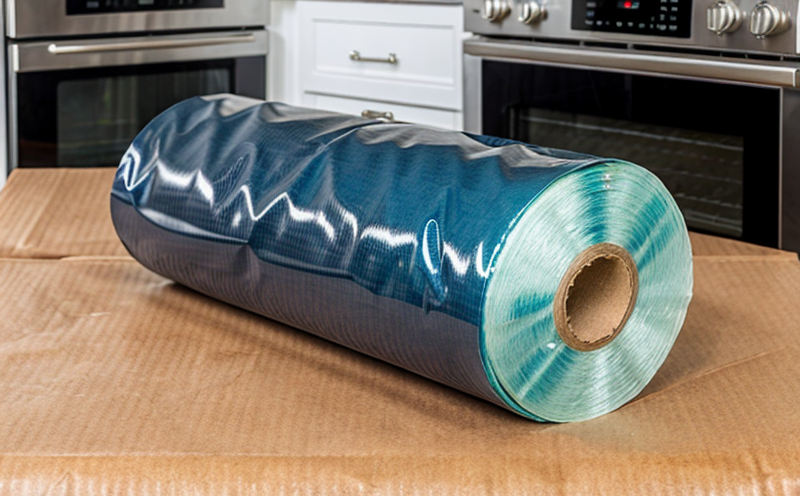EN ISO 22007 Thermal Conductivity Testing of Plastic Wraps
The EN ISO 22007 standard provides a framework for testing the thermal conductivity properties of plastic wraps, which is critical in various sectors including food packaging and insulation. This service ensures that producers and manufacturers can meet stringent quality standards, guaranteeing the integrity and performance of their products.
Thermal conductivity plays a vital role in determining how effectively a material prevents heat transfer from one side to another. In the case of plastic wraps used for household applications, this property is essential for maintaining product efficacy, especially when it comes to food preservation or insulation against temperature fluctuations. The standard specifies precise methods and protocols that ensure accurate measurement of thermal conductivity under controlled conditions.
The testing process involves preparing specimens according to strict guidelines outlined in the EN ISO 22007:2019-05 document. This includes selecting appropriate sample sizes, ensuring uniformity across all samples, and controlling environmental factors such as temperature and humidity before testing begins. Once prepared, these samples are inserted into a thermal conductivity analyzer capable of measuring heat flow through them at specified intervals.
The analysis typically follows an inverse Fourier method where the amount of time taken for heat to pass through the sample is measured. This data helps calculate the thermal resistance (R-value) which is inversely proportional to the thermal conductivity value. By comparing this R-value against industry benchmarks, manufacturers can assess whether their product meets required performance levels.
Understanding these values allows companies not only to comply with regulatory requirements but also to optimize their products for better efficiency and sustainability. For instance, by minimizing unwanted heat transfer, plastic wraps designed according to this standard help reduce energy consumption during storage or transportation processes.
In addition to compliance benefits, EN ISO 22007 testing offers several advantages that contribute directly to product development and quality assurance efforts within the industry:
- Enhanced reliability: Consistent results across multiple tests ensure consistent product performance.
- Improved accuracy: Advanced analytical techniques provide precise measurements leading to more accurate evaluations of material properties.
- Increased competitiveness: By adhering to global standards, businesses can differentiate themselves by offering superior quality products.
Applied Standards
The EN ISO 22007 standard is widely recognized and applied across many industries dealing with plastic materials. It specifies the procedure for determining the thermal conductivity of rigid or flexible plastics using steady-state methods. This includes both laboratory testing machines as well as portable devices suitable for field applications.The key aspects covered by this standard include:
- Apparatus and equipment used in the determination.
- Preparation of test specimens including cutting dimensions, surface roughness, and conditioning procedures.
- Measurement techniques such as guarded hot plate method or hot disk method.
- Data processing and presentation formats for reporting results.
This comprehensive approach ensures that all factors influencing thermal performance are accounted for, providing reliable data upon which informed decisions can be made about material selection and design optimization.
Scope and Methodology
The scope of EN ISO 22007 includes the determination of steady-state thermal conductivity of rigid or flexible plastics. This covers both laboratory testing machines as well as portable devices suitable for field applications.The methodology involves several steps:
- Selection and preparation of test specimens.
- Application of heat to the specimen surface while maintaining a constant temperature difference between two opposite faces.
- Determination of heat flux through the sample using appropriate measurement techniques (e.g., guarded hot plate method).
- Data acquisition, analysis, and reporting of thermal conductivity values based on calculated results.
It is important to note that proper specimen preparation is crucial for obtaining accurate measurements. Specimens should be cut into standard sizes with smooth surfaces free from defects or irregularities. They must also be conditioned under specified conditions before testing begins, typically involving exposure to a controlled environment for at least 24 hours.
The choice of measurement technique depends on the type and thickness of plastic being tested. For thinner films, the guarded hot plate method may not be suitable due to its inability to accommodate very thin samples accurately. In such cases, the hot disk method or similar approaches might be preferable as they offer better precision when dealing with smaller specimens.
Benefits
Adhering to EN ISO 22007 standards brings numerous benefits to manufacturers and distributors of plastic wraps, particularly those targeting the household market. Compliance ensures that products meet stringent quality assurance criteria set forth by international bodies, thereby enhancing consumer confidence in brand reliability.Here are some key advantages:
- Enhanced Product Reliability: Consistent results across multiple tests ensure that consumers receive products with predictable performance characteristics.
- Improved Accuracy: Advanced analytical techniques provide precise measurements leading to more accurate evaluations of material properties.
- Increased Competitiveness: By adhering to global standards, businesses can differentiate themselves by offering superior quality products.
- Sustained Compliance: Regular verification against these standards helps maintain regulatory compliance over time, avoiding costly penalties and reputational damage.
Beyond just meeting legal requirements, EN ISO 22007 testing contributes significantly to product development by providing valuable insights into how changes in formulation or processing affect thermal conductivity. This knowledge enables continuous improvement of existing products while paving the way for innovation in new applications.





